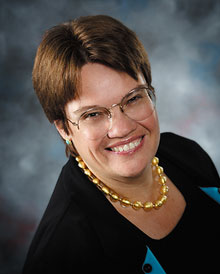  |
| HOME | THIS ISSUE | CALENDAR | GRANTS | BACK ISSUES | < BACK | NEXT > |
Law professor one of nation's leading experts on subprime lendingby Michael Kirk - January 26, 2009
|
||||
| When Patricia McCoy was a law professor in Cleveland, Ohio in the 1990s, each day she drove through a neighborhood called Hough that was changing before her eyes. Once stricken by poverty and riots and long-sullied by empty storefronts and ramshackle homes, it began undergoing a transformation, thanks to new public and private investment in the area. Uninhabitable homes were being razed, new buildings were under construction, and businesses were opening. “There was a real sense of pride in the neighborhood,” says McCoy, now a professor at the UConn Law School and a specialist in banking and securities regulation. But before long, she began hearing reports that some of these new homes were already in foreclosure – only a short time after new residents bought them. “I wondered why a lender would make a loan to somebody who was so likely to go into foreclosure,” she recalls. “I started to fear that the turnaround was fragile.” She suspected there was a double standard when it came to lending: while the more affluent were offered legitimate loans, poorer people were being offered predatory terms many did not fully understand and could not afford. “I saw that there was a very serious issue regarding how banking affected ordinary people, particularly those of modest means,” she says. “My Cleveland colleague, Kathleen Engel, and I were disturbed and felt we had to get to the bottom of subprime lending, beginning in late 1999 and 2000.” While she did not predict the global enormity of its implications, she knew that sort of risky lending spelled trouble down the road. What McCoy was seeing was the beginnings of the subprime lending crisis that would eventually lead to the collapse of the U.S. economy and world financial markets in the fall of 2008. Campaign adviser She was also one of the experts advising the presidential campaign of Barack Obama, and has continued to advise the transition team on current and emerging issues and policy options to deal with them. “We were encouraged to have a diversity of ideas and a very vigorous debate,” she says. Roots of the problem At that time, however, the subprime market was relatively small. Subprime loans mushroomed between 2003 and 2007. What went from being highly risky in 2003 snowballed in the next five years to being totally unsustainable, she says. McCoy identifies two main sources of blame: “One consists of lenders and Wall Street: Wall Street manufactured artificial demand for subprime loans because investors could make a high rate of return, and lenders slashed their underwriting standards to provide the volume of loans that Wall Street wanted.” She says the second source of blame is the federal government. Although Congress severely deregulated mortgages in the 1980s, federal regulators still had a lot of tools at their disposal to stop lax underwriting, she says.
“They knew what was going on in ’05 and failed to stop it.” She says part of the reason may be that banks are essentially allowed to shop around for their own regulators, and agencies would soft-pedal their regulations to keep the banks from going elsewhere. The Federal Reserve System – one of the entities now scrambling to keep the U.S. economy afloat – also bears responsibility, she says: “With the Fed, it was ideological. The big expansion of subprime lending happened under Alan Greenspan, who felt boom-and-bust economies led to greater growth.” McCoy saw this up close: from 2002 until 2004, she served on the Consumer Advisory Council of the Federal Reserve Board of Governors, and chaired the Council’s Consumer Credit Committee. “I was able to observe first hand the vacillation of the Fed about what to do with subprime loans,” she says. Despite protracted discussions with the Fed’s staff and governors, she adds, “it was very difficult to get any movement.” Evaluating the response She is disappointed that the portion of TARP designed to buy troubled assets has not worked. “We have a huge number of distressed borrowers, our foreclosure rates continue to spiral upwards, and that’s going to get worse unless we get serious about providing realistic relief,” she says. “That’s going to require a radical government law that abrogates mortgage or servicing contracts.” She’s not sure whether Congress has the stomach for that. But some relief may be in sight with a proposal in Congress to allow bankruptcy judges to cut the principal on distressed debtors’ home loans. For the future, McCoy sees room for “modest optimism,” but rates the odds that the economy will improve rather than slide deeper into recession or depression because of the housing crisis at only 50-50. “Until we stop having so many foreclosed houses dumped on the market, prices will continue to drop,” she says. “If we can salvage more homeowners, the housing market will bottom out and start to go up again.” Together with Kathleen Engel, her longtime co-author, McCoy is writing a book on the crisis for Oxford University Press. She has also worked with UConn economics professor Stephen Ross on subprime research. She is now focused on finding ways to address the massive flaws that the housing crisis has exposed in the U.S. financial, economic, and regulatory systems. |
| ADVANCE HOME UCONN HOME |

